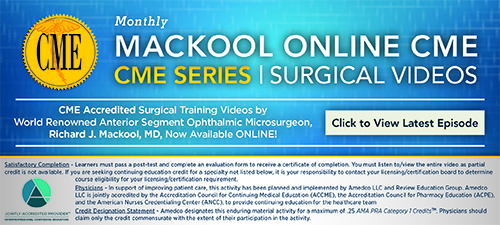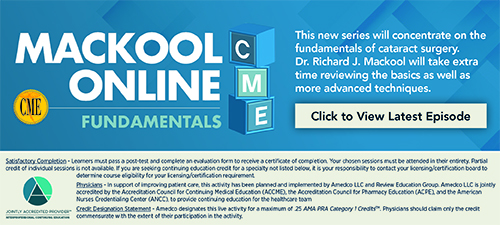| |
|
|
|
| Vol. 20, #43 • Monday, October 12, 2020 |
|
OCTOBER IS HALLOWEEN SAFETY MONTH
|
|
|
| |
|
Ten-year Survival Trends of nAMD at First Presentation
Researchers described 10-year trends in visual outcomes, anatomical outcomes and treatment burden of individuals receiving anti-vascular endothelial growth factor therapy for neovascular age-related macular degeneration.
The retrospective cohort study included treatment-naïve, first-affected eyes with nAMD started on ranibizumab before January 1, 2009. The primary outcome was time to best-corrected visual acuity falling ≤35 ETDRS letters after initiating anti-VEGF therapy. Secondary outcomes included: time to BCVA reaching ≥70 letters; proportion of eyes with BCVA ≥70 and ≤35 letters in 10 years; mean trend of BCVA and central retinal thickness over 10 years; and mean number of injections.
Here were some of the findings:
• For the cohort of 103 patients, Kaplan-Meier analyses demonstrated median time to BCVA reaching ≤35 and ≥70 letters were:
o 37.8 (CI, 22.2 to 65.1) and 8.3 (CI, 4.8 to 20.9) months after commencing anti-VEGF therapy, respectively.
• At the final follow-up, BCVA was ≤35 letters and ≥70 letters:
o in 41.1 percent and 21 percent, respectively, in first-affected eyes;
o in 5.4 percent and 48.2 percent, respectively, in a patient’s better-seeing eye.
• Mean injection number was 37 ±24.2 per eye and 53.6 ±30.1 at patient level (63.1 percent of patients required injections in both eyes).
Researchers wrote that one in five individuals retained good vision (BCVA ≥70 ETDRS letters) in the first-affected eye at 10 years after starting anti-VEGF treatment, and one in two patients had good vision in their better-seeing eye. They added that early treatment of nAMD was associated with better visual outcomes and that the chronicity of nAMD disease and its management highlighted the importance of long-term visual prognosis.
SOURCE: Arpa C, Khalid H, Chandra S, et al. Ten-year survival trends of neovascular age-related macular degeneration at first presentation. Br J Ophthalmol 2020; Oct 3. [Epub ahead of print].
|
|
|
|
|
| |
Complimentary CME Education Videos
|
|
|
|
| |
|
Choriocapillaris Flow Deficit as a Risk Factor for AMD Progression
Investigators evaluated the association between choriocapillaris (CC) flow deficits and structural OCT biomarkers, and the progression of intermediate AMD (iAMD) to complete retinal pigment epithelial and outer retinal atrophy (cRORA).
They conducted a retrospective analysis of consecutive patients with iAMD with a minimum follow-up of 12 months. From logistic regression, investigators estimated:
• odds ratios of intraretinal hyperreflective foci (IRHF);
• hyporeflective drusen cores (hDC);
• subretinal drusenoid deposits (SDD);
• presence of drusen volume (DV) ≥0.03 mm within a central 3-mm circle, fellow eye with late stage of AMD;
• CC FD at baseline; and
• months of follow-up.
A total of 112 eyes with iAMD were included. Here were some of the findings:
• Eyes that progressed were significantly more likely to show IRHF, hDC and DV ≥0.03 mm.
• The CC flow deficit was significantly greater in eyes that developed cRORA.
• IRHF, hDC, DV ≥0.03 mm and higher CC flow deficit were significantly and independently associated with the development of cRORA.
Investigators concluded that CC flow deficits were significantly greater in iAMD eyes that progressed to cRORA, and remained an independent risk factor when structural OCT biomarkers were considered. They added that CC flow deficit may be useful for enhancing risk stratification and prognostication of individuals with iAMD.
SOURCE: Corvi F, Tiosano L, Corradetti G, et al. Choriocapillaris flow deficit as a risk factor for progression of age-related macular degeneration. Retina 2020 Sep 28. [Epub ahead of print].
|
|
|
|
|
|
|
| |
Complimentary CME Education Videos
|
|
|
|
|
| |
|
Preoperative Falls in Medicare Patients Awaiting Cataract Surgery
Scientists wrote that delaying cataract surgery was associated with an increased risk of falls, but it was unknown whether routine preoperative testing delayed cataract surgery long enough to cause clinical harm. They sought to determine whether the use of routine preoperative testing led to harm in the form of delayed surgery and falls in Medicare beneficiaries awaiting cataract surgery.
The retrospective, observational cohort study using 2006 to 2014 Medicare claims involved Medicare beneficiaries age 66 and older with CPT claims for ocular biometry.
Scientists measured the mean and median number of days between ocular biometry and cataract surgery; calculated the proportion of patients waiting >30 days or >90 days for surgery; and determined the odds of having a fall within 90 days of biometry among patients of high-testing physicians (testing performed in ≥75 percent of their patients) compared with patients of low-testing physicians. They estimated the number of days of delay attributable to high-testing physicians relative to other factors that may determine surgical scheduling.
Main outcome measures included incidence of falls occurring between biometry and surgery, odds of falling within 90 days of biometry and estimated delay in days associated with physician testing behavior.
Of 248,345 beneficiaries, 16.4 percent were patients of high-testing physicians. Here were some of the findings:
• More patients of high-testing than low-testing physicians waited >30 days (31.4 and 8.2 percent) and >90 days (25 and 5.5 percent)(p<0.0001 for both) to have cataract surgery.
• Falls before cataract surgery in patients of high- vs. low-testing physicians increased by 43 percent within the 90 days following ocular biometry (1 vs. 0.7 percent, p<0.0001).
• The adjusted odds ratio of falling within 90 days of biometry in patients of high- vs. low-testing physicians was 1.10 (CI, 1.03, 1.19, p=0.008).
• After adjusting for surgical wait time, the odds ratio decreased to 1.07 (CI, 1.00 to 1.15; p=0.06).
• The delay associated with having a high-testing physician was approximately eight days (estimate, 7.97; CI 6.40, 9.55; p<0.0001).
• Other factors associated with delayed surgery included patient race (non-white), northeast geographic region, ophthalmologist age ≤40 and low surgical volume.
Scientists found that overuse of routine preoperative medical testing by high-testing physicians was associated with delayed surgery and increased falls in cataract patients awaiting surgery.
SOURCE: Chen CL, McLeod SD, Lietman TM, et al. Preoperative medical testing and falls in Medicare beneficiaries awaiting cataract surgery. Ophthalmology 2020; Sep 11. [Epub ahead of print].
|
|
|
|
|
| |
|
Association Between Obstructive Sleep Apnea and XFS: The Utah Project
Researchers wrote that since exfoliation syndrome (XFS) is a systemic disorder with genetic predisposition due to variations in lysyl oxidase-like 1 (LOXL1) function, leading to altered elastin matrices in ocular and systemic tissues, and obstructive sleep apnea (OSA) is a highly prevalent disorder also involving elastic tissue dysfunction found to have associations with glaucoma, that there might be a relationship between the two. They performed a case-control retrospective cohort study to find out.
A cohort of 81,735 individuals diagnosed with OSA at ages 50 to 90 years were identified from medical records (1996 to 2017) in the Utah Population Database. Case subjects were matched to random controls on sex and birth year in a 4:1 ratio. International Classification of Diseases, Ninth Revision (ICD-9) codes or their ICD-10 equivalent were used to define a diagnosis of OSA (ICD-9 327.23) and a diagnosis of XFS (ICD-9 365.52 and 366.11). Conditional logistic regression odds ratios accounting for individual matching on sex and birth year was used to estimate the risk of XFS in OSA patients. Models included adjustments for race, obesity, tobacco use, hypertension, atrial fibrillation and chronic obstructive pulmonary disease. The primary outcome was whether OSA patients had an increased risk of diagnosis of XFS compared with non-OSA population controls.
Researchers found an increased risk of an XFS diagnosis in OSA patients compared with non-OSA controls (OR=1.27; CI, 1.02 to 1.59; p=0.03). In a stratification of patients by hypertension diagnosis history, OSA patients with hypertension exhibited an increased risk of XFS compared to non-OSA controls with hypertension (OR=2.67; CI, 2.06 to 3.46; p<0.0001).
Researchers reported that individuals with OSA may be at an increased risk of XFS compared with those without OSA, particularly in those with a history of hypertension.
SOURCE: Shumway C, Curtin K, Taylor S, et al. Association between obstructive sleep apnea and exfoliation syndrome: The Utah Project on Exfoliation Syndrome. Ophthalmol Glaucoma 2020; Sep 29. [Epub ahead of print].
|
|
|
|
|
|
|
|
| |
Advertisement
|
|
|
|
|
Industry News
In Memoriam: Alan Crandall, MD
One of ophthalmology’s luminaries, Utah’s Alan Crandall, MD, passed away in early October from a sudden illness.
Dr. Crandall was a warm, giving person who was also an innovator in ophthalmic surgery and glaucoma. One of his greatest, ongoing achievements of his 39-year career at the University of Utah’s Moran Eye Center was the founding of the center’s Global Outreach Division. Through this special division, Dr. Crandall trained surgeons in various countries around the world, and provided free cataract surgery both in underserved areas of the United States, as well as in Asia and Africa. Everyone who’s benefited from his treatments, his teachings or his friendship will miss him greatly.
Read more.
Novartis Beovu Shows Improvement in BCVA in Wet AMD Patients with Early Persistent Fluid
Novartis announced that results of two new post-hoc analyses of its Phase III HAWK and HARRIER clinical trials in wet age-related macular degeneration were presented at the EURETINA 2020 virtual congress. The company says the first analysis demonstrated fewer Beovu (brolucizumab) patients had early persistent fluid when compared with aflibercept patients. Patients with early persistent fluid treated with Beovu achieved greater best-corrected visual acuity gains and reductions in central subfield thickness the company says. A second analysis showed Beovu was associated with better control of retinal fluid. Read more.
Kodiak Treats First Patients in Three Phase III Studies of KSI-301
Kodiak Sciences announced the first patients were treated in the randomized, double-masked GLEAM, GLIMMER and BEACON Phase III studies of KSI-301, Kodiak's anti-VEGF antibody biopolymer conjugate, in treatment-naïve patients with diabetic macular edema (GLEAM and GLIMMER) and macular edema due to retinal vein occlusion (BEACON). U.S. recruitment in Kodiak's ongoing global DAZZLE Phase IIb/III study of KSI-301 in treatment-naïve wet age-related macular degeneration is now complete. Read more.
Tarsus Releases Data from Io and Europa Trials for TP-03
Tarsus Pharmaceuticals announced data from its Phase II trials, Io (a Phase IIa, single-arm open-label trial) and Europa (a Phase IIb, randomized vehicle-controlled trial), evaluating the safety and efficacy of TP-03, a novel ophthalmic therapeutic for the treatment of Demodex blepharitis. Both studies produced data on the safety, efficacy and tolerability of TP-03, consistent with findings from the company's previous Mars and Jupiter Phase II trials the company says. Read more.
Eyevensys Receives FDA Orphan Drug Designation for EYS611
Eyevensys announced the FDA granted an orphan-drug designation for EYS611 for the treatment of retinitis pigmentosa. Eyevensys is developing EYS611, a DNA plasmid that encodes for the human transferrin protein, to help patients diagnosed with RP and other degenerative retinal diseases. Transferrin is an endogenous protein that helps manage iron levels in the eye, as excessive iron has been associated with photoreceptor death in several retinal degenerative diseases. By acting as an iron chelating and neuroprotective agent, EYS611 helps slow the progression of diseases such as RP regardless of the specific genetic mutation causing the condition, the company says. Read more.
Data Released on Phase III Trials of Upneeq for Acquired Ptosis
RVL Pharmaceuticals announced JAMA Ophthalmology published pooled analysis of data from two company-sponsored Phase III clinical trials of Upneeq (oxymetazoline hydrochloride ophthalmic solution) 0.1% for treatment of acquired blepharoptosis in adults showing the treatment was associated with positive outcomes after instillation on days one and 14 and was well-tolerated. Upneeq is a preservative-free eye drop administered once daily to ptotic eye(s). Read more. Read more.
|
|
|
|
|
|
| |
Review of Ophthalmology® Online is published by the Review Group, a Division of Jobson Medical Information LLC (JMI), 19 Campus Boulevard, Newtown Square, PA 19073.
To subscribe to other JMI newsletters or to manage your subscription, click here.
To change your email address, reply to this email. Write "change of address" in the subject line. Make sure to provide us with your old and new address.
To ensure delivery, please be sure to add reviewophth@jobsonmail.com to your address book or safe senders list.
Click here if you do not want to receive future emails from Review of Ophthalmology Online.
Advertising: For information on advertising in this e-mail newsletter or other creative advertising opportunities with Review of Ophthalmology, please contact sales managers Michael Hoster, Michele Barrett or Jonathan Dardine.
News: To submit news or contact the editor, send an e-mail, or FAX your news to 610.492.1049
|
|
|
|
|
|
|
|